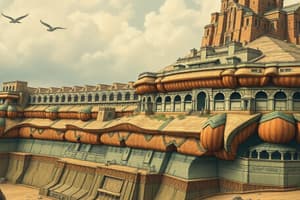Podcast
Questions and Answers
What is the Law of Superposition?
What is the Law of Superposition?
- The principle that each layer of sedimentary rock is older than the layer above it. (correct)
- A type of rock formed from particles or remains of organisms.
- A technique to determine the actual age of fossils.
- A record of geologic events and life forms.
What is sedimentary rock?
What is sedimentary rock?
A type of rock that forms when particles from other rocks or the remains of plants and animals are pressed and cemented together.
What is a fossil?
What is a fossil?
A trace of an ancient organism that has been preserved in rock.
What is relative dating?
What is relative dating?
What is absolute dating?
What is absolute dating?
What is an index fossil?
What is an index fossil?
What does the Geologic Time Column represent?
What does the Geologic Time Column represent?
What is seafloor spreading?
What is seafloor spreading?
What is continental drift?
What is continental drift?
Flashcards are hidden until you start studying
Study Notes
Law of Superposition
- A principle in geology that determines the relative ages of sedimentary rock layers.
- In horizontal layers, each layer is older than the one above it and younger than the one below.
- The youngest layer is at the top and the oldest is at the bottom.
Sedimentary Rock
- Formed through the compaction and cementation of particles from existing rocks or organic materials.
- Key components include minerals, fragments of other rocks, and biological remains.
Fossil
- Represents preserved remains or traces of ancient living organisms found in sedimentary rock.
- Provides critical information about past life forms and the environment.
Relative Dating
- Involves determining the age of an object or event in relation to others.
- Does not provide exact dates but rather sequences in geological history.
Absolute Dating
- Involves techniques that assess the actual age of fossils or rock layers.
- Uses methods like radiometric dating to pinpoint specific ages.
Index Fossil
- Refers to fossils of organisms known to have existed during a specific geological time frame.
- Useful for dating and correlating the age of rock layers across different locations.
Geologic Time Column
- A visual representation of Earth's geological history, outlining major events and life forms.
- Helps establish the timeline of Earth's evolution and major geological changes.
Seafloor Spreading
- A geological process where new oceanic crust forms at mid-ocean ridges as tectonic plates diverge.
- Contributes to the movement of continents and the overall structure of the Earth’s crust.
Continental Drift
- A theory proposing that continents were once part of a single landmass that fragmented and drifted apart.
- Explains the geographical distribution of continents and related geological phenomena.
Studying That Suits You
Use AI to generate personalized quizzes and flashcards to suit your learning preferences.




